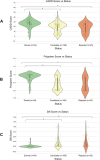Enriched phenotypes in rare variant carriers suggest pathogenic mechanisms in rare disease patients
- PMID: 39825393
- PMCID: PMC11740427
- DOI: 10.1186/s13040-024-00418-5
Enriched phenotypes in rare variant carriers suggest pathogenic mechanisms in rare disease patients
Abstract
Background: The mechanistic pathways that give rise to the extreme symptoms exhibited by rare disease patients are complex, heterogeneous, and difficult to discern. Understanding these mechanisms is critical for developing treatments that address the underlying causes of diseases rather than merely the presenting symptoms. Moreover, the same dysfunctional series of interrelated symptoms implicated in rare recessive diseases may also lead to milder and potentially preventable symptoms in carriers in the general population. Seizures are a common and extreme phenotype that can result from diverse and often elusive pathways in patients with ultrarare or undiagnosed disorders.
Methods: In this pilot study, we present an approach to understand the underlying pathways leading to seizures in patients from the Undiagnosed Diseases Network (UDN) by analyzing aggregated genotype and phenotype data from the UK Biobank (UKB). Specifically, we look for enriched phenotypes across UKB participants who harbor rare variants in the same gene known or suspected to be causally implicated in a UDN patient's recessively manifesting disorder. Analyzing these milder but related associated phenotypes in UKB participants can provide insight into the disease-causing mechanisms at play in rare disease UDN patients.
Results: We present six vignettes of undiagnosed patients experiencing seizures as part of their recessive genetic condition. For each patient, we analyze a gene of interest: MPO, P2RX7, SQSTM1, COL27A1, PIGQ, or CACNA2D2, and find relevant symptoms associated with UKB participants. We discuss the potential mechanisms by which the digestive, skeletal, circulatory, and immune system abnormalities found in the UKB patients may contribute to the severe presentations exhibited by UDN patients. We find that in our set of rare disease patients, seizures may result from diverse, multi-step pathways that involve multiple body systems.
Conclusions: Analyses of large-scale population cohorts such as the UKB can be a critical tool to further our understanding of rare diseases in general. Continued research in this area could lead to more precise diagnostics and personalized treatment strategies for patients with rare and undiagnosed conditions.
Keywords: Compound heterozygous; Rare diseases; Recessive conditions; Seizures; Variant carriers.
© 2025. The Author(s).
Conflict of interest statement
Declarations. Ethics approval and consent to participate: The authors declare no competing interests. This work was performed in accordance with all ethical guidelines outlined in the NIH IRB #15HG0130. The study proposal and manuscript were approved by the Undiagnosed Diseases Network (UDN) Publications and Research Committee. Consent for publication: All patients are consented as part of their enrollment into the UDN in accordance with the UDN manual of operations [52]. Competing interests: The authors declare no competing interests.
Figures




References
-
- Crooke ST. A call to arms against ultra-rare diseases. Nat Biotechnol. 2021;39(6):671–7. - PubMed
-
- Angelis A, Tordrup D, Kanavos P. Socio-economic burden of rare diseases: a systematic review of cost of illness evidence. Health Policy. 2015;119(7):964–79. - PubMed
-
- Gene map statistics - OMIM. https://www.omim.org/statistics/geneMap. Accessed 11 Jul 2024.
Grants and funding
LinkOut - more resources
Full Text Sources
Research Materials
Miscellaneous

